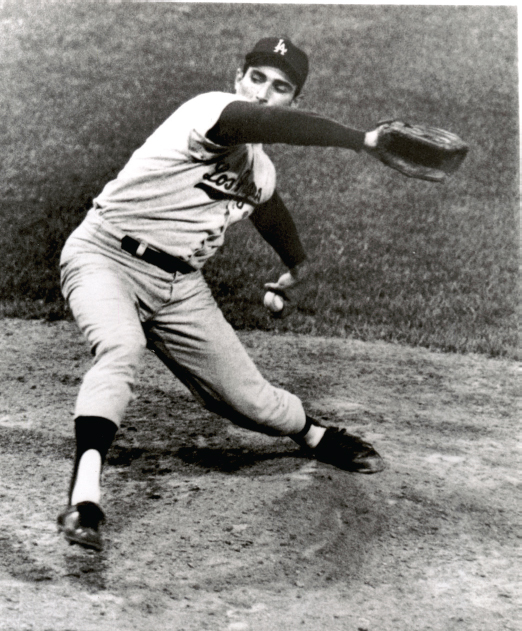September 10, 1963: Sandy Koufax wins 23rd game in record-setting performance in Pittsburgh
 Skipper Walter Alston’s National League-leading 1963 Los Angeles Dodgers (87-57) probably looked forward to a rare day off on Monday, September 9, after playing 21 games in 20 consecutive days. They had lost the final two games of a three-game set in San Francisco at the beginning of a 13-game road trip, their final road swing of the season, to see their lead drop to just three games over the streaking St. Louis Cardinals.
Skipper Walter Alston’s National League-leading 1963 Los Angeles Dodgers (87-57) probably looked forward to a rare day off on Monday, September 9, after playing 21 games in 20 consecutive days. They had lost the final two games of a three-game set in San Francisco at the beginning of a 13-game road trip, their final road swing of the season, to see their lead drop to just three games over the streaking St. Louis Cardinals.
“The Cardinals don’t worry me right now,” declared Alston, whose club was engaged in its fourth suspenseful September pennant race in five seasons and its third in a row.1 The levelheaded Alston took one game at a time, preparing his team for a three-game series against the Pittsburgh Pirates (69-74) as if the slumping eighth-place club was a contender.
“We’re a great deal more relaxed than this time last season,” stated veteran outfielder Wally Moon, comparing his squad to the ’62 team that lost the pennant to the Giants in a tiebreaker series.2
A reason for the Dodgers’ calm demeanor and confidence was Sandy Koufax, who had been limited to just 8 2/3 innings over the final 10 weeks of the 1962 season. Koufax’s return to dominance in 1963 was nothing short of stunning. After a breakout season in 1961, during which he set an NL record with 269 strikeouts and went 18-13, Koufax emerged as baseball’s best pitcher in 1962. He was leading the majors with a 2.06 ERA and 208 strikeouts, and trailing teammate Don Drysdale’s majors-best 15 wins by one on July 12, when he was sidelined by a debilitating finger injury and circulatory condition known as Raynaud’s syndrome. As Mark Z. Aaron writes in his SABR biography of the pitcher, the condition of Koufax’s index finger was so severe that a threat of amputation existed.3
Fears about Koufax’s career arose again in early 1963 when he missed three starts, but the 27-year-old once again took the league by storm. Entering the September 10 game against the Pirates, he was in hot pursuit of the first pitcher’s Triple Crown in the NL since 1938, leading the majors with 22 wins, 267 strikeouts, and a 1.98 ERA.
While Koufax inspired his teammates, skipper Danny Murtaugh’s Bucs were bumbling through a disappointing campaign. Losers of 11 of their last 13 games, the Pirates had harbored pennant aspirations after a 93-win season in 1962. After trading three infield starters in the offseason (Dick Stuart, Don Hoak, and Dick Groat) and a starting outfielder early in the ’63 campaign (Bob Skinner), however, the Pirates struggled to score runs – and get wins.
Toeing the rubber for the Pirates against the Dodgers was Don Cardwell, a rugged 6-foot-4 right-hander acquired in the trade of fan favorite Groat to the Cardinals. The 27-year-old was coming off the most effective stretch in his career (August 6 to September 1), having won six straight decisions with a 1.26 ERA in seven starts and 57 innings. His 13-13 slate (3.11 ERA) had improved his career record to 60-83.
On a cool, 60-degree Tuesday evening, Forbes Field welcomed a crowd of 11,152 for the fifth game of a 14-game homestand, the Pirates’ final one of the season.4
The Dodgers came out swinging against Cardwell. Leadoff hitter and reigning NL MVP Maury Wills was “robbed” of a hit by Gold Glove second baseman Bill Mazeroski.5 After Moon laced a two-out single, Tommy Davis executed a perfect hit-and-run. When Mazeroski sprinted to cover second, Davis’s grounder bounded through the open infield gap, enabling Moon to reach third. Ron Fairly blasted a “shot against the right field screen,” reported Pirates beat writer Les Biederman, driving in Wills for the game’s first run.6
Koufax was in dominant form in a season filled with highlights, including a no-hitter against the Giants on May 11, two two-hit shutouts, and six three-hitters. He retired the Pirates in order in the first inning and pitched around single baserunners in each of the next three innings. His strikeout of Cardwell swinging in the third was his 270th of the season, breaking his own NL record set in 1961.
The Dodgers’ bats kept the pressure on in the middle innings. Jim Gilliam and Davis clipped Cardwell for singles in the third, as did John Roseboro and the .052-hitting Koufax in the fourth. Though Cardwell escaped both innings without giving up a run, he lost center fielder Bill Virdon on Koufax’s blooper. According to Pittsburgh sportswriter Jack Hernon, Virdon tried to make a diving catch but landed head-first on the grass hard enough to suffer a concussion. He left the game in fifth because of blurred vision and went to the hospital.7
The Dodgers caught a break in the sixth with Fairly on first with a one-out walk. Frank Howard hit an apparent tailor-made inning-ending double-play grounder to third, but rookie Bob Bailey threw the ball “past second into right field,” reported Biederman.8 Fairly scampered home on the three-base error to give the Dodgers a 2-0 lead.
Los Angeles increased its lead to 4-0 in the seventh. Gilliam slapped a one-out single and trotted home on Moon’s eighth home run of the season, a blast to deep right. Cardwell finished the seventh, charged with four runs (three earned) on nine hits. Graybeard Harvey Haddix, who at 37 years old had moved into a relief role in his 12th major-league season, tossed two scoreless frames, fanning five.
Koufax began the bottom of the seventh with two quick outs, searching for his 11th shutout of the season to break the AL-NL record he shared with Carl Hubbell, who accomplished the feat in 1933 with the New York Giants.
But fate intervened. Tommy Davis was moved from third to left at the beginning of the frame as part of Alston’s four-player defensive realignment. A terrific hitter en route to his second consecutive NL batting title, Davis was a defensive liability and had already made “one of his frequent poor throws from third,” wrote Dodgers beat reporter Frank Finch, resulting in an error in the third inning.9
Ted Savage, who had replaced Virdon as a pinch-hitter two innings earlier and remained in the game in left field, laced a single to left. The ball went through Davis’s legs, enabling Savage to scamper to third on a two-base error. Bailey followed with a single to drive in Savage, cutting the Dodgers’ lead to 4-1. In an uncommon show of emotion for the normally stoic pitcher, Koufax kicked the dirt on the mound and then “slammed the resin bag to the ground out of sheer disappointment,” wrote Finch.10 Still, Koufax struck out pinch-hitter Johnny Logan to end the inning.
Roberto Clemente proved to be Koufax’s biggest nemesis in this game. In the last previous clash of these future Hall of Famers, on July 25, Clemente had blasted a three-run home run to help the Pirates to a 6-2 victory.11 In this contest, Clemente singled in the fourth and beat out an infield hit to third in the sixth. With two outs in the eighth, he blasted a solo home run, his 16th round-tripper of the season, to pull the Bucs to within two, 4-2. “Clemente always gives me trouble,” muttered Koufax after the game.12 “[He] hit his home run on a slider,” said the southpaw. “I’ve been throwing it only for the last two weeks.”13
Koufax set down the Pirates in order in the ninth to complete his 19th game of the season in 2 hours and 19 minutes. It was his 23rd victory of the season, a new record for a Dodgers left-hander, breaking the mark he shared with Nap Rucker (1911) and Preacher Roe (1951). Koufax made 132 pitches in his six-hitter and did not issue a walk, and his victory gave him the distinction of having beaten all nine NL opponents in 1963. Koufax finished the game with nine punchouts to extend the record to 276.14
“The Dodgers certainly don’t give the impression of a team looking over their shoulder,” wrote Biederman.15 Alston’s squad maintained its three-game lead over the Cardinals, who had defeated the Chicago Cubs, 8-0, for their 13th win in 14 games.
Given the exciting pennant race, sportswriters immediately questioned Koufax if the coming Rosh Hashanah holy day on Wednesday, September 18, the final day of a pivotal three-game set in St. Louis, would affect his pitching schedule. A man of faith who refused to pitch on the Jewish holidays of Rosh Hashanah and Yom Kippur, Koufax brushed the queries aside and said he planned on making three starts in eight days. “If everything goes well,” said Koufax of his next start in Philadelphia, “I’d like to pitch in St. Louis Tuesday with only two days’ rest.”16
Ultimately, Koufax pitched against the Philadelphia Phillies on two days’ rest on September 13, departing with a 1-0 deficit after seven innings and receiving a no-decision. He then pitched on three days’ rest against the Cardinals on September 17, spinning his record-setting 11th shutout, 4-0.17
Acknowledgments
This article was fact-checked by Bruce Slutsky and copy-edited by Len Levin.
Photo credit: Sandy Koufax, SABR-Rucker Archive.
Sources
In addition to the sources cited in the Notes, the author accessed Retrosheet.org, Baseball-Reference.com, SABR.org and the following:
Finch, Frank. “Koufax Opposes Pirates’ Cardwell Tonight,” Los Angeles Times, September 10, 1963: III, 1.
https://www.baseball-reference.com/boxes/PIT/PIT196309100.shtml
https://www.retrosheet.org/boxesetc/1963/B09100PIT1963.htm
Notes
1 Lester J. Biederman, “Dodgers Inching Toward NL Flag,” Pittsburgh Press, September 11, 1963: 56.
2 “Dodgers Inching Toward NL Flag.”
3 Mark Z. Aaron, “Sandy Koufax,” SABR BioProject, https://sabr.org/bioproj/person/Sandy-Koufax. Accessed March 2025.
4 “The Weather,” Pittsburgh Post-Gazette, September 10, 1963: 23.
5 Lester J. Biederman, “Dodger Broadcaster Scully Lives, Dies with Photo Finish,” Pittsburgh Press, September 11, 1963: 57.
6 “Dodger Broadcaster Scully Lives, Dies with Photo Finish.”
7 Jack Hernon, “Dodgers Clip Bucs, 4-2; Koufax Sets Mark,” Pittsburgh Post-Gazette, September 10, 1963: 29.
8 Biederman, “Dodgers Inching Toward NL Flag.”
9 Frank Finch, “Koufax Tames Bucs, 4-2, for 23rd Win,” Los Angeles Times, September 11, 1963: III, 1.
10 “Koufax Tames Bucs, 4-2, for 23rd Win.”
11 The Pirates’ 6-2 victory was their only win in 12 games on the West Coast in 1963, losing all six to the Giants and going 1-5 against the Dodgers.
12 Biederman, “Dodgers Inching Toward NL Flag.”
13 George Lederer, “Koufax and Drysdale ‘Lost’?” Long Beach (California) Press-Telegram, September 11, 1963: D1.
14 Koufax completed the season with 306 strikeouts, a record that stood until he surpassed it with 382 strikeouts in 1965.
15 Biederman, “Dodgers Inching Toward NL Flag.”
16 Associatd Press, “Sandy’s Faith Changes Rotation,” Venice (California) Evening Vanguard, September 11, 1963: 23.
17 Koufax finished 1963 with a 25-5 record, a 1.82 ERA, and 306 strikeouts, attaining the pitching Triple Crown. The Dodgers won the NL pennant by six games over the Cardinals, then swept the New York Yankees in the World Series. Koufax won both of his World Series starts, setting a World Series record with 15 strikeouts in Game One and winning the Series-clinching Game Four. He received the NL Cy Young and MVP Awards for 1963.
Additional Stats
Los Angeles Dodgers 4
Pittsburgh Pirates 2
Forbes Field
Pittsburgh, PA
Box Score + PBP:
Corrections? Additions?
If you can help us improve this game story, contact us.


